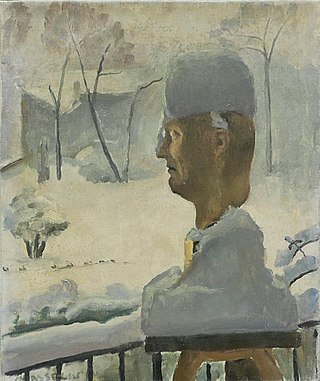
Jean-Baptiste Madou was a Belgian painter and lithographer.

Georges Stein, born Séverin Louis Stein, was a French Impressionist artist. Stein was a painter and draughtsman, and is known primarily for light-infused views of Paris and London. He also painted scenes from Melun, Vichy, Bern, Geneva, and Monte Carlo.

Auguste-Barthélemy Glaize (1807–1893) was a French Romantic painter of history paintings and genre paintings.
Pierre Tal-Coat was a French artist considered to be one of the founders of Tachisme.
Louis Robert Bate was a French sculptor, as was his wife Juliette Briet-Bate. He was a pupil of Jules Coutan and Paul Landowski and a member of the Société Coloniale des Artistes Français and won in succession, second prize of the Prix de Rome in 1927, bursary for residence at the Villa Velázquez Madrid in 1932, bursary for French Equatorial Africa, Prix de Guadeloupe in 1935, and Prix de l'Indochine in 1938. In Indochina he gained permanent employment at the school of architecture in Dalat till his death aged 50.

Paul Biva was a French painter. His paintings, both Realist, Naturalist in effect, principally represented intricate landscape paintings or elaborate flower settings, much as the work of his older brother, the artist Henri Biva (1848–1929). Paul Biva was a distinguished member of National Horticultural Society of France from 1898 until his untimely death two years later.

Jean-Baptiste-Antoine Guillemet was a French renowned landscape painter and longtime Jury member of the Salon des Artistes Francais. He was one of the first 19th-century artists to paint modern life, and a pivotal figure in the transition from Realism to Impressionism.

Louise-Joséphine Sarazin de Belmont (1790–1871) was a French landscape painter and lithographer.

Eugène Lepoittevin, also known as Poidevin, Poitevin, and Le Poittevin, was a French artist who achieved an early and lifelong success as a landscape and maritime painter. His work ranged from erotic caricatures to massive battle scenes. His works are in the collections of many museums throughout France. He made many paintings set in and around the fishing village of Étretat, and in 2020 he was the subject of an exhibition and book, L'invention d'Étretat: Eugène Le Poittevin, un peintre et ses amis à l'aube de l'impressionnisme.

Auguste-Xavier Leprince was a French artist and painter who attained celebrity at the age of seventeen. His patrons included the Duchesse de Berry, Charles X, and Alexandre du Sommerard. He was also a teacher; in his twenties he established his own atelier in Paris, with pupils including his two younger brothers, Robert-Léopold and Pierre-Gustave, as well as Eugène Lepoittevin and Nicolas Alexandre Barbier. His meteoric career came to an abrupt end and his "brilliant promise was cut short by his premature death at the age of twenty-seven."

Benn (Bencjon Rabinowicz) (1905–1989) was a painter associated with the School of Paris. His early work was mostly figurative; much of his later work is inspired by the Bible, particularly the Book of Psalms.

Paul Claude-Michel Carpentier was a French portrait, genre, history painter and author. He studied with Jean-Jacques Lebarbier (1738–1826) and briefly with Jacques-Louis David (1748–1825). Until 1824 he exhibited at the Salons under his family name LeCarpentier, but after 1824 shortened his last name to Carpentier.
Jeannine Baticle was a French art historian, and curator, She was the Honorary Deputy Director and Chief Curator of the Department of Paintings of the Louvre Museum, and a specialist in Spanish painting.

Blanche Hennebutte-Feillet (1815–1886) was a French lithographer and painter. She is remembered in particular for the lithographs she created for albums illustrating Bayonne and the Basque Country. As a painter, she exhibited in the Paris salon from 1841.

Pierre Henry Prosper Baccuet was a French military officer and landscape painter; known primarily for his Orientalist scenes.

William Julien Emile Edouard Laparra was a French painter of portraits and genre scenes. The composer, Raoul Laparra, was his younger brother.

René François Xavier Prinet was a French painter and illustrator who drew his subjects from middle-class society.

Henri-Achille Zo was a French painter and illustrator of Basque ancestry. His work was part of the art competitions at the 1928 Summer Olympics and the 1932 Summer Olympics.

Charles-Caius Renoux was a French painter, lithographer, and illustrator. He first achieved success with paintings of medieval churches, particularly the ruins of cloisters and monasteries destroyed during the French Revolution, works for which he is still best known. Renoux also painted landscapes, large-scale battle scenes, and historical subjects, works which uniquely prepared him for the final phase of his career, the creation of spectacular dioramas, the "moving pictures" of the era. He also taught at the École des Beaux-Arts in Paris; his notable students included Narcisse Berchère and Hector Hanoteau.

Maurice Paul Jean Asselin was a French painter, watercolourist, printmaker, lithographer, engraver and illustrator, associated with the School of Paris. He is best known for still lifes and nudes. Other recurring themes in his work are motherhood, and the landscapes and seascapes of Brittany. He also worked as a book illustrator, particularly in the 1920s. His personal style was characterised by subdued colours, sensitive brushwork and a strong sense of composition and design.


















